





Volume: 5 Issue: 2 - 2002
| REVIEW | |
| 1. | Experimental and Correlative Approaches with Respect to Causality and Contribution to the Goals of Positive Sciences Sibel KARAKAŞ Pages 72 - 81 This article discusses the concept of positive sciences from various angles. In this context, the article introduced the two basic approaches of positive sciences, the experimental and the correlative ones. The criteria and the assumptions of the positive sciences, the concept of causality that emanates from the principle of determinism, and the criteria for causality are explained. The degrees to which the experimental and correlative approaches satisfy the criteria of causality are discussed. The article introduced the goal of positive sciences and included a comparative analysis of the two approaches with respect to each of these goals. In closing up, the article discussed the relative importance of the experimental and the correlative approaches for studies in positive sciences. |
| RESEARCH ARTICLE | |
| 2. | Comparision of Sociodemographic, Clinic and Psychopathologic Features of The Early And Late Onset Alcohol Dependent Males Ahmet İNCE, Zuhal DOĞRUER, Hakan Türkçapar Pages 82 - 91 It's suggested that the age of onset of alcohol dependecy has clinical importance. The aim of this study is to compare epidemio-logic data, personality features, additional mental ilnesses and various psychologic symptoms of early and late onset male alcoholics. 47 male patients who were hospitalized because of alcohol dependency were assessed by using socio-demographic data questionnaire, SCID-l, SCID-II, Short Symptom Inventory, Beck Anxiety Inventory and CIWA-Ar. It's found that 66%of patients have comorbid Axis-1 and/or 2 diagnosis, and 51,9%of patients have comorbid Axis-2 diagnosis. The rate of alcohol use in first- degree relatives, the rate of antisocial personality disorder and major depression were found higher in early onset alcoholics. As these two alcohol dependency groups have different features, the etiologic investigation of these groups will provide new prophylaxis and treatment approaches. |
| REVIEW | |
| 3. | Axis I Psychiatric Co-morbidity Among Treatment-Seeking Heroin Dependents: It's Relation with Socio- Demographic and Substance Use Properties Cüneyt Evren, Fatma Oya ER, Murat ERKİ RAN, Duran Çakmak Pages 92 - 104 The aim of this study was to evaluate the prevalence of axis-1 psychiatric co-morbidity in patient with heroin dependence and to compare socio-demographic features with to compare with control group and substance related features according to the presence ofaxis-I psychiatric co-morbidity in heroin dependents. The study was conducted between June and September 2001 in AMATEM Clinic (Bakırköy Psychiatric and Mental Disorders Research and Training Hospital, Alcohol and Drug Research and Treatment Center). The sample consisted of 62 male and 8 female opiate (heroin) dependent patients according to DSM-IV criteria, those who finished detoxification treatment. Control group consisted of 51 subjects, those who do not use alcohol or substance and similar to sample according to gender and age. All the psychiatric diagnoses are made by using Structured Clinical Interview for DSM-IV (SCID). Sixty seven percent of the heroin dependents were estimated as having any co-morbid axis I disorder. Having any affective disorder was found in 50% of the sample, while ratio of having any anxiety disorder was 52.9%. In heroin dependent group, lifetime major depression was found in 35.7%, major depression in last month in 21.7%, substance related depressive disorder in 12.9% and adjustment disorder in 22.9% of the sample. These ratios found in heroin dependent group was higher than control group. Although it is not statistically meaningful, ratio of those who started to use substance under the age of 18 and those who use more than 2gr heroin a day was found to be higher among patients with co-morbid axis I disorder. Also ratio of using heroin by injecting was higher among group with co-morbid axis I disorder. Finding the frequency of having any co-morbid axis I disorders among heroin dependents higher than the control group in our sample and finding some of the properties that might be related to addiction severity higher among those who had co-morbid axis I disorder, suggest that special care must be given to identify and to treat this co-morbid conditions. Co-morbid axis I and axis II disorders and their relation with severity of dependency and relapse need to be studied in substance dependent population. |
| 4. | Executive Functions and Attentional Processes: Theoretical Models and Neuroanatomy Birim Günay KILIÇ Pages 105 - 110 The dynamic and complex nature of information processing in defining high-level cognitive functions has lead to the concept of executive functions. Today, the diagnoses of psychiatric disorders are being made on a phenomenological basis. Other than the cognitive and emotional dimension of behavior, the dimension of executive functions is used to identify the underlying cognitive mechanisms in psychiatric disorders. The aim of this paper is to review the theoretical models related to cognitive processes like executive functions and attention and their cerebral correlates. Another aim of the current paper is to emphasize the theoretical overlaps between memory, attention and executive functions. |
| 5. | The Etiology of Attention Deficit Hyperactivity Disorder: An Integrative Approach Bedriye ÖNCÜ, Selahattin Şenol Pages 111 - 119 Attention deficit hyperactivity disorder (ADHD) is a common disorder that is persistent with a varying array of manifestations from preschool age through adulthood. The fact that it may be complicated with other psychiatric disorders and social problems, and the advantage of available treatment methods places ADHD among the most important disorders in child and adoles-cent psychiatry. Despite the high prevalence of the disorder, there is no consensus for a single etiologic factor. This paper reviews the literature on the etiology of attention deficit hyperactivity disorder through an integrative perspective. |
| 6. | Components of Visuospatial abilities Murat Kurt Pages 120 - 125 In this article components of visuospatial process is defined. Although visual perception and visuospatial perception is so related to each other they described different phenomenon. Visual perception is important for object recognition, while visuospatial perception is important for spatial perception and visuo- motor performance. Visuospatial processes include perception of space, visualization and orientation, visuospatial scanning,speed of response, impulsivity, and focused or sustained attention. Since visuospatial abilities are multifactorial, in clinical applications, there is a necessity for using different neuropsychological tests which are sensitive to functions of different components of visuospatial abilities. |










